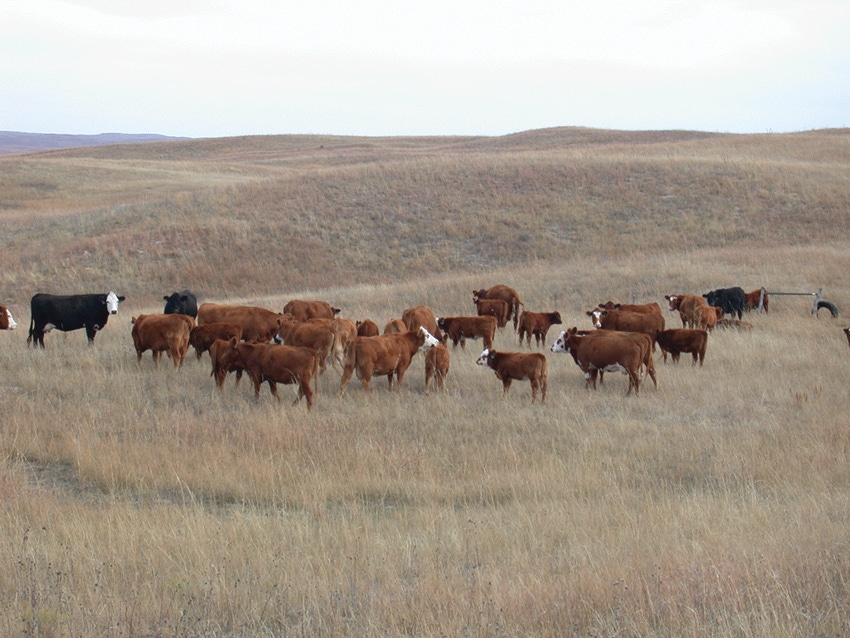Here’s how you can use stockpiled forages to extend the grazing season.
October 3, 2016

Finding ways to stretch fall and winter feed, reducing the need for harvested hay, can lower beef producers’ costs. One method is to stockpile pastures, grazing them later in the season.
But depending on a variety of factors, Mother Nature chief among them, cows grazing stockpiled pastures may need a little nutritional boost as winter weather grips the landscape.
“Typically, the quality of stockpiled perennial forage in terms of protein and energy is more than adequate to meet requirements of a pregnant beef cow in her first and second trimester,” says Bart Lardner, Western Beef Development Center, University of Saskatchewan.
“As days get colder, however, with winter wind the forage may not meet requirements, and you’ll have to step in with some kind of supplement,” he says.
 The need for supplement, and the type needed, will depend on pasture quality and condition of the cows. “If they’re in good body condition going into stockpiled pastures, they can maintain condition until weather gets cold. This can change from one week to the next, and cows may start to lose condition. Using a supplement adds cost, but you may still want to prolong the grazing period,” Lardner says.
The need for supplement, and the type needed, will depend on pasture quality and condition of the cows. “If they’re in good body condition going into stockpiled pastures, they can maintain condition until weather gets cold. This can change from one week to the next, and cows may start to lose condition. Using a supplement adds cost, but you may still want to prolong the grazing period,” Lardner says.
Grasses that don’t retain quality and nutrients during winter can be used with a little protein supplement, which is usually cheaper than feeding hay. “Our killing frosts are generally in early October. By November or December, producers are starting to graze stockpiled winter pastures,” says Jerry Volesky, range and forage specialist, University of Nebraska-Lincoln.
For the first month or two, the forage quality is still fairly good. But by January, it’s usually wise to provide a protein supplement, he says.
According to Tim DelCurto, Nancy Cameron chair of the Department of Animal and Range Sciences at Montana State University, it can be hard to determine forage quality; it is not always consistent year to year in the same pastures. While at Oregon State University’s Eastern Oregon Agricultural Center, DelCurto did research in the Great Basin and some work at the research station at Union, Ore., with fescue.
“Winter weather has a profound impact on the quality of stockpiled forage. A cold Arctic blast drives quality down,” DelCurto says. “The plant might have had some green through fall, but extreme cold temperatures takes the green right out.
“On the flip side, in a mild winter with some precipitation, some plants will actually green up. The quality fluctuation is dynamic,” he says. Producers must adjust their management to environmental variation.
“Be strategic in supplementation. Protein is usually the main focus. Alfalfa hay is usually a good supplement for beef cattle on stockpiled forages and can be fed every other day,” says DelCurto. This works in locations where you can get hay out to the cattle. If terrain is too rough, you might haul blocks or tubs periodically and let cattle eat those free-choice.
 “The important thing is to not feed too much. The goal is to just feed enough protein to meet cows’ nutritional requirements and optimize intake of stockpiled forage. In studies we did in the Great Basin, we found that 3 to 6 pounds of alfalfa per head [daily] was ideal,” he says. “If we fed more, we were just replacing some of the forage they would otherwise eat, with minimal increase in cattle performance.
“The important thing is to not feed too much. The goal is to just feed enough protein to meet cows’ nutritional requirements and optimize intake of stockpiled forage. In studies we did in the Great Basin, we found that 3 to 6 pounds of alfalfa per head [daily] was ideal,” he says. “If we fed more, we were just replacing some of the forage they would otherwise eat, with minimal increase in cattle performance.
“On stockpiled tame pastures, we’ve gotten by fairly well with a barley-soybean meal supplement that’s about 30% crude protein, feeding 3 pounds per head per day, or about 21 pounds a week. We compared feeding daily vs. three times weekly, and it came out about the same,” DelCurto says.
How to stockpile forages?
The advantages of grazing stockpiled forages are many, the researchers say. But how best to plan your management approach?
Volesky says there are a couple ways to do this. One is to use annual forages planted in summer. Another option is to use perennial forages that were lightly grazed during summer, or not grazed at all until fall or winter.
The limiting factor is buildup of ice and snow that hinders accessibility. “We conducted a three-year study here and each year was different. The first year we had an open fall and grazed into January. The second year we had deep snow by late October. You have to work with what Mother Nature gives you,” says Lardner.
Forage species
Volesky mentions a producer who plants sorghum-sudan grass and cuts it once for hay, then leaves it growing until frost. “After frost, he grazes that standing stockpiled forage.”
Summer annuals work well for this, as do “cocktail” mixes that include warm- and cool-season species. “These contain cool-season forages like oats, turnips, oilseed radishes, and a warm-season forage like millet or sudangrass, planted in August. These mixes grow until frost and can accumulate a lot of growth, with 1.5 to 2 tons per acre by the time they are grazed,” Volesky says.
“With mixes, it’s best to wait until well after frost to graze, because with warm-season annuals you can run into prussic acid problems after frost. Let them freeze down all the way; then by November, they can usually be safely grazed,” Volesky says.
Some cool-season species like oats or turnips wouldn’t be completely frozen yet; a mix provides good nutrient quality, he explains. There is always something that does well even when growing conditions vary from year to year.

70 photos show ranchers hard at work on the farm
Readers have submitted photos of hard-working ranchers caring for their livestock and being stewards of the land. See reader favorite photos here.
Perennial pastures can be grazed lightly in spring or not at all, saving them for fall grazing. “This can work with both cool- and warm-season perennial grasses. They are mature by the time they are grazed, but when they freeze down in the fall, whatever stage of growth and maturity they were at that time [in terms of quality] is captured at that stage — similar to what it would be if it were cut for hay at that point. Over winter there will be slow deterioration of the plant; leaves fall off or blow away, so quality will eventually decline,” says Volesky.
Some grasses stockpile better than others. “A common practice where producers grow a lot of tall fescue is to graze it early, then let regrowth accumulate. Tall fescue stockpiles fairly well for later use,” says Volesky.
Ryegrasses are often used for fall and winter grazing. Depending on the variety and climate, these may be annuals or perennials. “Also, the farther south you are, they keep growing longer into winter, providing high-quality green forage. In Oklahoma, for instance, they stay green all winter long,” he says.
Nearly any forage species can be stockpiled, but for perennials, Lardner suggests using cool-season grasses because they maintain quality better as the season progresses. Research evaluating cool-season grasses for this purpose has looked at brome grasses, fescues, wheat grasses and some of the legumes, he says.
“We see a lot of leaf loss with alfalfa, especially if it’s left standing. Cattle are grazing mostly stems. Even in a windrow you get some leaf loss. Alfalfa is better for a late-summer grazing system than stockpiled for fall and winter grazing,” says Lardner.
“Wheat grasses, such as crested wheat, are good, and some of the rye grasses like Russian wild rye also hold their protein well into fall. These are known as both spring- and/or fall-grazing species,” Lardner adds.
Some of the fescues work well, especially creeping red fescue or tall fescue. Smooth bromegrass and meadow bromegrass can also work. “We mostly looked at tame forages, but there is also potential to utilize some of the native meadow grasses someone might choose to pasture into the fall rather than put up as hay,” according to Lardner.
Tame grasses vs. native range
“When we stockpile tame pastures, we may graze early and take the cattle off to allow some regrowth. This holds the phenology back a little; grass will be shorter and less mature — higher in nutritional value in the fall than if it had been growing all summer and completely mature,” DelCurto says. Likewise, early-cut hay meadows that have adequate regrowth are good candidates for stockpiled forage.

Clinton and Trump: Where they stand on ag
As the election nears, find out where the candidates stand on agriculture, including their plans, potential farm bills, trade and more. Get the details.
“We sometimes try this on rangelands, but many regions are so arid that timing grazing to allow adequate regrowth is tricky,” he says. Most Western rangelands can only be grazed once. If you want to graze in the fall, you don’t graze then at all in the spring.
“Best management practices often encourage producers and/or range managers to not graze during growing season. For Great Basin ranges, some people say it should be grazed only once every three years during growing season. It’s better to graze it out of season, when it’s dormant. These ranges are often best deferred in use — for fall and winter grazing,” DelCurto explains.
This gives the grass every opportunity to recover, grow and go to seed. Grazing when it’s dormant has very little impact on root reserves of the plant; you are using aboveground material when it’s not trying to grow.
You might also like:
Young ranchers, listen up: 8 tips from an old-timer on how to succeed in ranching
13 utility tractors that will boost efficiency in 2016
Burke Teichert: How to cull the right cow without keeping records
3 weaning methods compared; Which one rises to the top?
6 tips for proper electric fence grounding
9 things to include in your ag lease (that you better have in writing!)
You May Also Like
.png?width=300&auto=webp&quality=80&disable=upscale)


